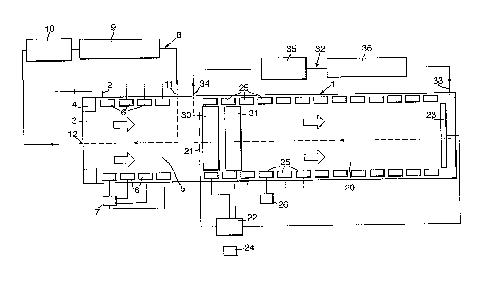Some of the information on this Web page has been provided by external sources. The Government of Canada is not responsible for the accuracy, reliability or currency of the information supplied by external sources. Users wishing to rely upon this information should consult directly with the source of the information. Content provided by external sources is not subject to official languages, privacy and accessibility requirements.
Any discrepancies in the text and image of the Claims and Abstract are due to differing posting times. Text of the Claims and Abstract are posted:
| (12) Patent: | (11) CA 2913531 |
|---|---|
| (54) English Title: | ION MOBILITY SPECTROMETERS |
| (54) French Title: | SPECTROMETRES DE MOBILITE IONIQUE |
| Status: | Granted and Issued |
| (51) International Patent Classification (IPC): |
|
|---|---|
| (72) Inventors : |
|
| (73) Owners : |
|
| (71) Applicants : |
|
| (74) Agent: | |
| (74) Associate agent: | |
| (45) Issued: | 2019-12-03 |
| (22) Filed Date: | 2008-03-06 |
| (41) Open to Public Inspection: | 2008-09-18 |
| Examination requested: | 2015-11-27 |
| Availability of licence: | N/A |
| Dedicated to the Public: | N/A |
| (25) Language of filing: | English |
| Patent Cooperation Treaty (PCT): | No |
|---|
| (30) Application Priority Data: | ||||||
|---|---|---|---|---|---|---|
|
An ion mobility spectrometer has a reaction region separated from a drift region by an electroststic gate. A doping circuit supplies a dopant to the reaction region but the drift region is undoped. Two high field ion modifiers are located one after the other in the drift region. One modifier can be turned on to remove dopant adducts from the admitted ions or both can be turned on so that the ions are also fragmented. In this way, several different responses can be produced to provide additional information about the nature of the analyte substance and distinguish from interferents.
Un spectromètre de mobilité ionique a une région de réaction séparée dune région de dérive par un portillon électrostatique. Un circuit de dopage fournit un dopant à la région de réaction, mais la région de dérive reste non dopée. Deux modificateurs dions de haute intensité sont positionnés lun derrière lautre dans la région de dérive. Un modificateur peut être activé pour retirer les adduits de dopant des ions admis ou les deux modificateurs peuvent être activés de façon à fragmenter les ions. Plusieurs réponses différentes peuvent ainsi être produites afin de fournir des renseignements supplémentaires sur la nature de la substance à analyser et de la distinguer des éléments interférents.
Note: Claims are shown in the official language in which they were submitted.
Note: Descriptions are shown in the official language in which they were submitted.

2024-08-01:As part of the Next Generation Patents (NGP) transition, the Canadian Patents Database (CPD) now contains a more detailed Event History, which replicates the Event Log of our new back-office solution.
Please note that "Inactive:" events refers to events no longer in use in our new back-office solution.
For a clearer understanding of the status of the application/patent presented on this page, the site Disclaimer , as well as the definitions for Patent , Event History , Maintenance Fee and Payment History should be consulted.
| Description | Date |
|---|---|
| Revocation of Agent Requirements Determined Compliant | 2022-05-04 |
| Revocation of Agent Request | 2022-05-04 |
| Change of Address or Method of Correspondence Request Received | 2022-05-04 |
| Common Representative Appointed | 2020-11-07 |
| Grant by Issuance | 2019-12-03 |
| Inactive: Cover page published | 2019-12-02 |
| Common Representative Appointed | 2019-10-30 |
| Common Representative Appointed | 2019-10-30 |
| Pre-grant | 2019-10-21 |
| Inactive: Final fee received | 2019-10-21 |
| Notice of Allowance is Issued | 2019-04-30 |
| Letter Sent | 2019-04-30 |
| 4 | 2019-04-30 |
| Notice of Allowance is Issued | 2019-04-30 |
| Inactive: Approved for allowance (AFA) | 2019-04-25 |
| Inactive: Q2 passed | 2019-04-25 |
| Amendment Received - Voluntary Amendment | 2018-11-08 |
| Inactive: S.30(2) Rules - Examiner requisition | 2018-05-11 |
| Inactive: Report - No QC | 2018-05-10 |
| Amendment Received - Voluntary Amendment | 2017-11-08 |
| Inactive: S.30(2) Rules - Examiner requisition | 2017-05-11 |
| Inactive: Report - No QC | 2017-05-11 |
| Amendment Received - Voluntary Amendment | 2016-11-28 |
| Inactive: S.30(2) Rules - Examiner requisition | 2016-05-30 |
| Inactive: Report - No QC | 2016-05-30 |
| Inactive: Cover page published | 2016-01-13 |
| Inactive: IPC assigned | 2015-12-14 |
| Inactive: First IPC assigned | 2015-12-14 |
| Divisional Requirements Determined Compliant | 2015-12-08 |
| Correct Applicant Requirements Determined Compliant | 2015-12-03 |
| Letter sent | 2015-12-03 |
| Letter Sent | 2015-12-03 |
| Correct Applicant Requirements Determined Compliant | 2015-12-03 |
| Application Received - Regular National | 2015-12-02 |
| Application Received - Divisional | 2015-11-27 |
| Request for Examination Requirements Determined Compliant | 2015-11-27 |
| All Requirements for Examination Determined Compliant | 2015-11-27 |
| Application Published (Open to Public Inspection) | 2008-09-18 |
There is no abandonment history.
The last payment was received on 2019-02-06
Note : If the full payment has not been received on or before the date indicated, a further fee may be required which may be one of the following
Patent fees are adjusted on the 1st of January every year. The amounts above are the current amounts if received by December 31 of the current year.
Please refer to the CIPO
Patent Fees
web page to see all current fee amounts.
Note: Records showing the ownership history in alphabetical order.
| Current Owners on Record |
|---|
| SMITHS DETECTION-WATFORD LIMITED |
| Past Owners on Record |
|---|
| JONATHAN RICHARD ATKINSON |